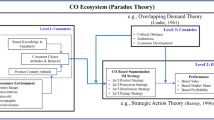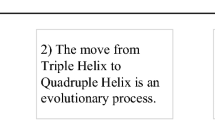Abstract
This paper studies multilevel determinants of product innovation by incumbent firms with data from 68 countries, covering over 25,000 firms in eight manufacturing sectors. The author assesses the predictions of interdisciplinary research on firm behavior in different contexts, which have emphasized that product innovation is affected by three sets of factors: the extent of global engagement, information spillovers, and market structure. The empirical model of the probability of observing a product innovation, a probit model, by a firm considers three levels of analysis: firm characteristics, industry characteristics, and the national context. The econometric evidence supports the global engagement and information spillovers hypotheses, but the evidence on the role of market structure is mixed. Regarding global engagement, the evidence suggests that product innovation by incumbent firms is positively correlated with the act of investing in R&D and licensing of foreign technologies, and country-level average import tariffs reduce the probability of product innovation. Regarding information spillovers, the evidence also shows that a country's patent density is positively correlated with product innovation. In contrast, concerning the market structure hypotheses, country-level indicators of business density and of policy-induced costs of entry are not robustly correlated with product innovation.
Similar content being viewed by others
References
Aghion, P., Bloom, N., Blundell, R., Griffith, R., & Howitt, P. 2005. Competition and innovation: An inverted-U relationship. The Quarterly Journal of Economics, 120 (2): 701–728.
Aghion, P., Blundell, R., Griffith, R., Howitt, P., & Prantl, S. 2006. The effects of entry on incumbent innovation and productivity. Harvard University, Cambridge, MA. http://post.economics.harvard.edu/faculty/aghion/papers.html.
Bamberger, P. 2008. Beyond contextualization: Using context theories to narrow the micro-macro gap in management research. Academy of Management Journal, 51 (5): 839–846.
Benito, G. R. G., Grogaard, B., & Narula, R. 2003. Environmental influences on MNE subsidiary roles: Economic integration and the Nordic countries. Journal of International Business Studies, 34 (5): 443–456.
Cohen, W. M., & Levin, R. C. 1989. Empirical studies of innovation and market structure. In R. Schmalensee & R. D. Willig (Eds), Handbook of industrial organization, 2: 1059–1107. New York: Elsevier Science Publishers.
Criscuolo, C., Haskel, J. D., & Slaughter, M. J. 2005. Global engagement and the innovation activities of firms, National Bureau of Economic Research Working Paper 11479 Cambridge, MA.
Djankov, S., Ganser, T., McLiesh, C., Ramalho, R., & Shleifer, A. 2007. The effect of corporate taxes on investment and entrepreneurship. World Bank and Harvard University. http://www.doingbusiness.org/MethodologySurveys/.
Eaton, J., & Kortum, S. 1996. Trade in ideas: Patenting and productivity in the OECD. Journal of International Economics, 3 (4): 251–278.
Habib, M., & Zurawicki, L. 2002. Corruption and foreign direct investment. Journal of International Business Studies, 33 (2): 291–307.
Hausmann, R., & Rodrik, D. 2003. Economic development as self-discovery. Journal of Development Economics, 72 (2): 603–633.
Heeley, M. B., Matusik, S. F., & Jain, N. 2007. Innovation, appropriability, and the underpricing of initial public offerings. Academy of Management Journal, 50 (1): 209–225.
Kaufmann, D., Kraay, A., & Mastruzzi, M. 2005. Governance matters IV: Governance indicators for 1996–2004, Policy Research Working Paper 3630, Washington, DC: World Bank.
Keller, W. 2004. International technology diffusion. Journal of Economic Literature, 42 (3): 752–782.
Klette, T. J., & Kortum, S. 2004. Innovating firms and aggregate innovation. Journal of Political Economy, 112 (5): 986–1018.
Klinger, B., & Lederman, D. 2006. Diversification, innovation, and imitation inside the global technological frontier, Policy Research Working Paper 3872, Washington, DC: World Bank.
Lederman, D., & Saenz, L. 2005. Innovation around the world, 1960–2000, Policy Research Working Paper 3774, Washington, DC: World Bank.
Luo, Y. 2001. Determinants of entry in an emerging economy: A multilevel approach. Journal of Management Studies, 38 (3): 443–472.
Luo, Y. 2002. Product diversification in international joint ventures: Performance implications in an emerging market. Strategic Management Journal, 23 (1): 1–20.
MacGarvie, M. 2006. Do firms learn from international trade? The Review of Economics and Statistics, 88 (1): 46–60.
Moulton, B. R. 1990. An illustration of a pitfall in estimating the effects of aggregate variables on micro units. The Review of Economics and Statistics, 72 (2): 334–338.
Nicita, A., & Olarreaga, M. 2006. Trade, production and protection 1976–2004, Policy Research Working Paper 2701 Washington, DC: World Bank.
Park, S. H., Li, S., & Tse, D. K. 2006. Market liberalization and firm performance during China's economic transition. Journal of International Business Studies, 37 (1): 127–147.
Reinganum, J. F. 1985. Innovation and industry evolution. The Quarterly Journal of Economics, 100 (1): 81–99.
Tihanyi, L., Griffith, D. A., & Russell, C. J. 2005. The effect of cultural distance on entry mode choice, international diversification, and MNE performance: A meta-analysis. Journal of International Business Studies, 36 (3): 270–283.
Venaik, S., Midgley, D. F., & Devinney, T. M. 2005. Dual paths to performance: The impact of global pressures on MNC subsidiary conduct and performance. Journal of International Business Studies, 36 (6): 655–675.
Acknowledgements
The author thanks the impeccable research assistance provided by Daniel Chodos and Javier Cravino. Roberto Alvarez, Bruce Blonigen, Pablo Fajnzylber, Rodrigo Fuentes, Alvaro González, José L. Guasch, J. Humberto López, Marcelo Olarreaga, Arjen Van Witteloostuijn, and two anonymous referees provided insightful comments on earlier drafts. Financial support from the World Bank's Latin American and Caribbean Regional Studies Program is gratefully acknowledged. The views expressed in this paper do not represent the views of the World Bank or of its member countries. All remaining errors are the responsibility of the author.
Author information
Authors and Affiliations
Corresponding author
Additional information
Accepted by Arjen van Witteloostuijn, Area Editor, 19 January 2009. This paper has been with the author for three revisions.
APPENDIX
APPENDIX
See Table A1.
Data Sources for Industry-Trade-Policy and Country-Level Variables Used in Regressions Presented in Table 3
Tariff index
The composite index was estimated as the first principal component derived from factor analysis of the trade-weighted applied tariffs and their standard deviations within each manufacturing industry. The data come from Nicita and Olarreaga (2006). The cross-country regressions use national averages of the industry averages.
NTB coverage rate
The variable measures the percentage of tariff lines that are subject to non-tariff barriers, which includes price control measures, finance control measures, and quantity control measures. The data come from Nicita and Olarreaga (2006). The cross-country regressions use national averages of the industry averages.
GDP per capita in 2000
Penn World Tables database.
Average real manufacturing GDP growth 1998–2003
The data come from the World Bank's database on World Development Indicators (WDI).
Stock of patents accumulated during 1963–2000 per worker
The variable is the total number of utility patents granted to the first innovator residing in each country and cited in the patent application at the US Patent and Trademark Office (USPTO) during this period. The data come from Lederman and Saenz (2005). The number of workers is the population 15–64 years of age in 2000. These data come from the World Bank's WDI.
Regulation index
The composite index was estimated as the first principal component derived from factor analysis of the difficulty of firing index, difficulty of hiring index, and starting a business time (days). These variables are the average by country for the years 2003, 2004, and 2005 (although some of these years may be missing for some variables for some countries). The data come from the World Bank's Doing Business database.
Infrastructure index
The composite index was estimated as the first principal component derived from factor analysis of the total road length in 2001 (km) (per square km of surface area) and main telephone lines (per 1000 habitants) in 2001. The data come from the World Bank's WDI.
Institutional index
The composite index was estimated as the first principal component derived from factor analysis of the control of corruption, political stability, and the rule of law. The data come from Kaufmann, Kraay, and Mastruzzi (2005).
Business density
Data are from Djankov et al (2007). This variable is defined as the number of firms per capita by country.
Rights and permissions
About this article
Cite this article
Lederman, D. An international multilevel analysis of product innovation. J Int Bus Stud 41, 606–619 (2010). https://doi.org/10.1057/jibs.2009.30
Received:
Revised:
Accepted:
Published:
Issue Date:
DOI: https://doi.org/10.1057/jibs.2009.30




